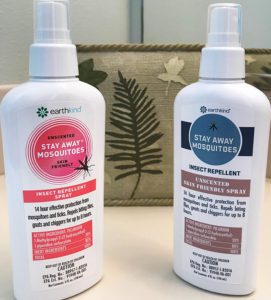Keeping Mosquitoes and Black Flies Away So You Can Garden
 Yes, that’s a long title for this blog post, but it really sums things up! I’ve been meaning to write about this topic for a few weeks but just haven’t had the time. But now that I’ve seen TV and newspaper accounts of the return of black flies to the Inland Northwest, it’s definitely important to address this subject.
Yes, that’s a long title for this blog post, but it really sums things up! I’ve been meaning to write about this topic for a few weeks but just haven’t had the time. But now that I’ve seen TV and newspaper accounts of the return of black flies to the Inland Northwest, it’s definitely important to address this subject.
I’ve lived in Spokane since 1978 and for decades, we never had black flies. Sure, we get a fair amount of mosquitoes in the spring but, as anyone who has been bitten by a black fly knows, those are just dreadful. Black flies essentially like to dive-bomb into your hair, into your ear, and completely ruin your gardening experience.
And those bites! Ugh. They primarily aim for your hairline. You don’t feel them biting, but afterwards, the area swells up, turns red, has bled, and the surrounding area becomes stiff and so uncomfortable.
So here’s what I do in order to lessen the chances of nasty encounters with black flies as well as mosquitoes:
- Now that these guys are in the area, I try not to garden in early morning or late in the day. Even though the temperatures are more pleasant at those times, that’s when black flies and mosquitoes are the most active.
- I wear lightly-colored clothes. Dark-colored clothes make us look like big animals and I’m pretty sure the black flies think, “ooh, there’s a big animal that I can suck dry!” (or something to that effect)
- If I’m wearing a shirt with a collar, I pull up the collar to protect my neck a bit. I know that might not look attractive but hey, we’re talking survival here!
- I also wear a hat with a big brim. In addition to providing important sun protection, those hats make it more difficult for the bugs to get to your hairline.
- Since mosquitoes lay their eggs in relatively still water, and black flies lay their eggs in running water, I place “mosquito dunks” in our ponds. This product contains Bt (Bacillus thuringiensis) israelensis, which kills their larvae… as well as the larvae of fungus gnats and white flies, in case you’re curious.
- This year, I started using a repellent containing the active ingredient of Picaridin. I really don’t like using sprays that contain DEET because I don’t feel they’re safe. Picaridin is a synthetic compound that very similar to a natural compound found in pepper plants (piperine). It’s considered safe to use, although some folks might develop a small rash from it. (however, I should mention that I have sensitive skin yet haven’t reacted to it in the least.)
The specific product I’m using is from EarthKind.com and it’s called Stay Away Mosquitoes. (see photo: note that both containers are the same product, just with different packaging)
My routine is to squirt some into my fingertips and then spread the solution on the back of my neck, edges of my ears, and along my hairline around to the front. I also add some to my arms if I’m wearing a short-sleeved shirt. The spray isn’t greasy or otherwise uncomfortable to use.
So far, I have not been bothered by black flies or mosquitoes at all, which is amazing because I tend to be a bug-magnet! I’m pretty sure I must taste delicious to bugs. So I am really pleased with how this is helping me survive the onslaught of these dreadful insects. Here’s a link to Stay Away Mosquitoes in case you’d like to check it out (and no, I’m not receiving any kickback if you order it).
Last but not least, there is a fact sheet on Picaridin if you’d like more information about it.
